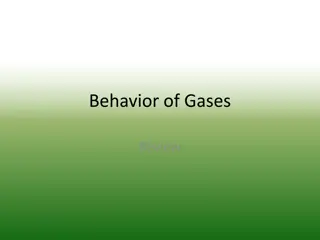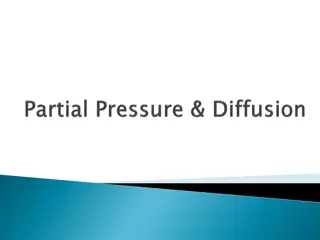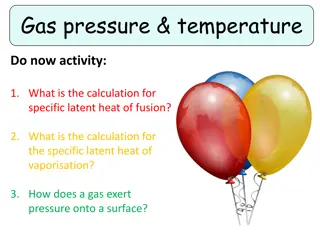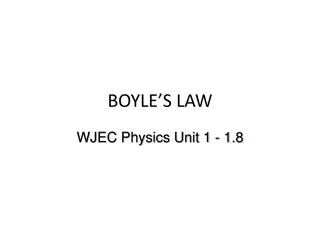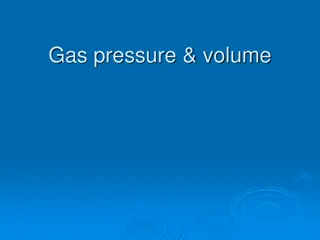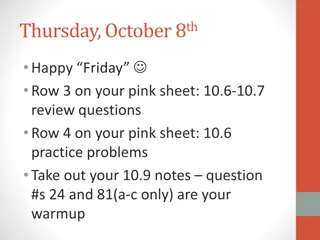Understanding Atmospheric Pressure and Gas Behavior
Exploring atmospheric pressure's impact on gas behavior, including Torricelli's barometer and Boyle's Law. Learn about gas volume changes with pressure variations and buoyant force principles. Prepare for Exam #1 covering chapters 1-8.
Download Presentation

Please find below an Image/Link to download the presentation.
The content on the website is provided AS IS for your information and personal use only. It may not be sold, licensed, or shared on other websites without obtaining consent from the author. Download presentation by click this link. If you encounter any issues during the download, it is possible that the publisher has removed the file from their server.
E N D
Presentation Transcript
Exam#1 (chapter 1-8) time: Wednesday 03/24 8:30 am- 9:20 am Location: physics building room 112 If you have special needs, e.g. exam time extension, and has not contact me before, please bring me the letter from the Office of the Dean of Students before 03/17. AOB multiple choice problems. Prepare your own scratch paper, pencils, erasers, etc. Use only pencil for the answer sheet Bring your own calculators No cell phones, no text messaging, no computers No crib sheet of any kind is allowed. Equation sheet will be provided. 1
Atmospheric Pressure and the Behavior of Gases Living on the surface of the earth, we are at the bottom of a sea of air. This sea of air is thinner at higher altitudes. It is also thinner during certain weather conditions. We describe this property by atmospheric pressure: the pressure of the layer of air that surrounds the earth. At sea level, the atmospheric pressure is 100 kPa, or 14.7 pounds per square inch, but it decreases with altitude.
Torricelli invented the barometer, a device for measuring atmospheric pressure. He filled a tube with mercury and inverted it into an open container of mercury. Air pressure acting on the mercury in the dish supported a column of mercury, of height proportional to the atmospheric pressure. For water: 32 feet = 975.36 cm For mercury: 975.36cm/13.6 = 72 cm. http://www.youtube.com/watch?v=BSo9fSTJcEE
Boyles Law Boyle discovered that the volume of a gas is inversely proportional to the pressure. Boyle s Law: PV = constant When temperature is contant. PV = nkT P = (n/V)kT. Number Density = n/V If the pressure increases, the volume decreases. P1V1 = P2V2 At higher altitude, the air density become smaller, i.e. larger volume, the air pressure become smaller. This is the reason of the balloon inflation.
Quiz: A fixed quantity of gas is held in a cylinder capped at one end by a movable piston. The pressure of the gas is initially 1 atmosphere (101 kPa) and the volume is initially 0.3 m3. What is the final volume of the gas if the pressure is increased to 3 atmospheres at constant temperature? P1 = 1 atm V1 = 0.3 m3 P2 = 3 atm V2 = ? 0.1 m3 0.3 m3 1 m3 3 m3 a) b) c) d) V2 = P1V1 / P2 = (1 atm)(0.3 m3) / 3 atm = 0.1 m3
buoyant force consider a block submerged in water, suspended from a string. The pressure of the water pushes on the block from all sides. Because the pressure increases with depth, the pressure at the bottom of the block is greater than at the top. There is a larger force (F = PA) pushing up at the bottom than there is pushing down at the top. The difference between these two forces is the buoyant force. Pascal s principle says: density*g*height is the same everywhere at the same height and in all directions. 6
2B-04 Liquid Pressure Investigating Pressure in different directions within a liquid in equilibrium. The increase in pressure gh is measured by the difference in height of the liquid in the U tube. What will happen to the reading on the manometer as the sensor is rotated ? g h A B A B AT ANY GIVEN POINT IN A STATIONARY LIQUID, THE PRESSURE IS THE SAME IN ALL DIRECTIONS. 7
2B-03 Water Seeks Own Level Liquid pressure depends on the height of the liquid column. But how is this height measured ? Investigating the Dependence of Pressure on Height The slanted cylinder and twisted cylinder hold a longer total length of water. But in each case the vertical height is the same. P = gh LIQUID PRESSURE DEPENDS ONLY ON VERTICAL HEIGHT (MEASURED STRAIGHT DOWN THAT IS PARALLEL TO g). 7/16/2024 Physics 214 Fall 2010 8
Archimedes Principle Archimedes Principle: The buoyant force acting on an object fully or partially submerged in a fluid is equal to the weight of the fluid displaced by the object. pressure = density*g*height buoyant force = difference between forces on top and bottom surface = (area*density*h)*g = mg = weight of the fluid displaced by the object. 9
2B-05 Pressure Forces in Liquids An open ended cylinder kept shut by liquid pressure What happens as the submerged cylinder filled with air is filled with water ? Air There are two forces acting on the plate. It s weight down and PA up. When PA exceeds the weight the cylinder stays intact PA In this situation the plate has to now support the weight of the water and when the weight of the water plus plate exceeds PA the cylinder opens Water PA 10
2B-10 Archimedes II Take the 1st reading before put the object into large beaker where the water level is just at the overflow point. One then submerge the object into the water while the displaced water is caught in a small beaker. Take the 2nd reading on the scale. One then put the overflowed water to the copper container, take the 3rd reading. The 3rd reading of the scale will A. Be the same as the 2nd reading. B. Be the same as the 1st reading C. Be smaller than the 1st reading. 11
2B-10 Archimedes II Use a scale to establish the relationship between the Buoyant Force on an object and the Weight of Fluid Displaced by the object T1 T3 T2 FB FB B C A WDF Mg Mg Mg A. The block is not immersed T1 = Mg B. The block is immersed but the liquid runs out T2 = Mg FB C. The displaced liquid is poured into the can T3 = Mg FB+ WDF T1 is found to equal T3 which means that the bouyant force FB is equal to WDF the Weight of the displaced Fluid THE BUOYANT FORCE IS EQUAL TO THE WEIGHT OF THE FLUID DISPLACED. 12
Quiz: Boat displaces 2.5 m3 of water. Density of water H2O = 1000 kg/m3. What is the mass of water displaced? What is the buoyant force? A). Mass = 2500 kg, buoyant force = 24500N B). Mass = 250 kg, buoyant force = 2450N C). Mass = 25 kg, buoyant force = 245N D). Mass = 2500 kg, buoyant force = 2450N E). Mass = 2500 kg, buoyant force = 245N Fb = WFD Mass of fluid displaced (mFD) = volume x density of fluid. MFD = VFD H2O = (2.5 m3)(1000 kg/m3) = 2500 kg Buoyant force equals weight of fluid displaced. Fb = WFD = mFD g = (2500 kg)(9.8 m/s2) = 24500 N 13
2A-08 Buoyancy of Air Investigating the Buoyant force resulting from Air After air being pumped out A. mb will move downward B. ma will move downward C. Apparatus remain balanced airgVb airgVa mag mbg Setting the sum of torques on equal-arm balance about pivot equal to zero, we have in the presence of air: mag airgVa = airgVb mag Vb > Vaimplies mb >mawhich is demonstrated in vacuum IF SENSITIVE WEIGHING OF AN OBJECT IS REQUIRED, UNEQUAL BUOYANT FORCES COULD AFFECT THE RESULTS. 14
Questions Chapter 9 Q1 Is it possible for a 100-lb woman to exert a greater pressure on the ground than a 250-lb man? Explain. Yes. The pressure will be mg/A so if A is small e.g. small heels the pressure will be very large Q3 The same force is applied to two cylinders that contain air. One has a piston with a large area, and the other has a piston with a small area. In which cylinder will the pressure be greater? The pressure is F/A so the one with the smallest A 7/16/2024 Physics 214 Fall 2010 15
Q4 A penny and a quarter are embedded in the concrete bottom of a swimming pool filled with water. Which of these coins experiences the greater downward force due to water pressure acting on it? Each coin has to support the weight of water in a vertical column so the quarter has the biggest force F =PA Q5 Why are bicycle tires often inflated to a higher pressure than automobile tires, even though the automobile tires must support a much larger weight? Once again the upward force has to support the weight so F = mg but F = PA where A is the area of the tire on the road so M/m = (PA)car/(Pa)bike so Ma/mA = Pcar /Pbike the ratio of the areas is smaller than the ratio of the weights so Pbike is higher. 7/16/2024 Physics 214 Fall 2010 16
Q6 The fluid in a hydraulic system pushes against two pistons, one with a large area and the other with a small area. A. Which piston experiences the greater force due to fluid pressure acting on it? B. When the smaller piston moves, does the larger piston move through the same distance, a greater distance, or a smaller distance than the smaller piston? A. The pressure is the same and F = PA so the larger piston has the larger force. B. The work done is the same so the small piston moves the most Q8 When a mercury barometer is used to measure atmospheric pressure, does the closed end of the tube above the mercury column usually contain air? No it needs to be a vacuum 7/16/2024 Physics 214 Fall 2010 17
Q9 Could we use water instead of mercury to make a barometer? What advantages and disadvantages would be associated with the use of water? The height of the liquid depends on the density. So one can use water but the column would be 32 feet high Q10 If you climbed a mountain carrying a mercury barometer, would the level of the mercury column in the glass tube of the barometer increase or decrease (compared to the mercury reservoir) as you climb the mountain? The pressure decreases because you have a smaller column of air to support so the height would decrease 7/16/2024 Physics 214 Fall 2010 18
Q11 If you filled an airtight balloon at the top of a mountain, would the balloon expand or contract as you descend the mountain? It would contract because the atmospheric pressure would increase and the pressure inside the balloon would increase to balance this change Q12 When you go over a mountain pass in an automobile, your ears often pop both on the way up and on the way down. How can you explain this effect? As you go up or down the atmospheric pressure changes and the popping is the inner ear adjusting to the pressure change 7/16/2024 Physics 214 Fall 2010 19
Q15 Is it possible for a solid metal ball to float in mercury? The upward force is the weight of liquid displaced and the downward force is the weight of the ball. If the density of the liquid is greater than that of the ball it will float. Q16 A rectangular metal block is suspended by a string in a breaker of water so that the block is completely surrounded by water. Is the water pressure at the bottom of the block equal to, greater than, or less than the water pressure at the top of the block? The pressure is gh so the pressure is higher at the bottom. The difference in pressure provides the upward force on the block 7/16/2024 Physics 214 Fall 2010 20
Q19 A large bird lands on a rowboat that is floating in a swimming pool. Will the water level in the pool increase, decrease, or remain the same when the bird lands on the boat? The buoyant force is the weight of liquid displaced so to support a larger weight more liquid is displaced and the level rises Q20 A rowboat is floating in a swimming pool when the anchor is dropped over the side. When the anchor is dropped, will the water level in the swimming pool increase, decrease, or remain the same? When the anchor is in the boat it s whole weight is supported and the amount of water displaced balances that weight. When it is thrown overboard it sinks and only displaces it s volume so the water level falls 7/16/2024 Physics 214 Fall 2010 21
Q22 If an object has the same density as water, will the object float to the top, sink to the bottom, or take neither course? Providing the object and water are incompressible the object will stay at whatever depth it is placed. It will not sink or rise. 7/16/2024 Physics 214 Fall 2010 22
Ch 9 E 4 Pressure of gas in piston = 300 N/m2. Area of Piston = 0.2m2. What is force exerted by piston on gas? A = 0.2m2 p = 300 N/m2 P = F/A, F = PA = 300 N/m2 (0.2 m2) = 60 N 7/16/2024 Physics 214 Fall 2010 23
Ch 9 E 6 Hydraulic system: A2 = 50 A1 F2 = 6000 N. What is F1? F2 = 6000N. A1 A2 Pressure is the same just underneath each piston F1/A1 = F2/A2 F2/F1 = A2/A1 = 50A1/A1 = 50 F1 = F2/50 = 6000/50 = 120N 7/16/2024 Physics 214 Fall 2010 24
Ch 9 E 8 T = constant, P1 = 10 kPa, V1 = 0.6 m3. P2 = 90 kPa, V2 = ? P1 = 10 kPa V1 = 0.6 m3 P2 = 90 kPa V2 = ? P1V1 = P2V2 (10 kPa)(0.6 m3)/(90 kPa) = V2 = 1/15 = 0.067 m3 7/16/2024 Physics 214 Fall 2010 25
Ch 9 E 12 Boat displaces 2.5 m3 of water. Density of water H2O = 1000 kg/m3. a) What is the mass of water displaced? b) What is the buoyant force? a) Mass of fluid displaced (mFD) = volume x density of fluid. MFD = VFD H2O = (2.5 m3)(1000 kg/m3) = 2500 kg Fb = WFD b) Buoyant force equals weight of fluid displaced. Fb = WFD = mFD g = (2500 kg)(9.8 m/s2) = 24500 N 7/16/2024 Physics 214 Fall 2010 26
Ch 9 E 14 Stream moves at v1 = 0.5 m/s in cross sectional area A1. Stream reaches point where A2 = A1. What is v2? V2 V1 A2 A1 a) v1A1 = v2A2 (0.5 m/s)(A1) = v2( A1) v2 = 2 m/s 7/16/2024 Physics 214 Fall 2010 27
Ch 9 E 16 Wing has a cross sectional area A = 10 m2. Wing experiences Lift = 60000 N. What is the difference in air pressure b/w top and bottom of wing? Pt A = 10m2 Pb 60000 N a) P = F/A , Pb PA = F/A = 60000N/10m2 = 6000Pa 7/16/2024 Physics 214 Fall 2010 28
Ch 9 CP 2 Water density = H2O = 1000 kg/m3. Depth of swimming pool = 3m. a) What is the volume of a column of water 3m deep and cross sectional area 0.5 m2? b) What is its mass? c) What is its weight? d) What is the excess pressure exerted on the pool bottom? e) Compare to atmospheric pressure. a) V = Ad = (0.5 m2)(3m) = 1.5 m3 b) M = V = (1.5 m3)(1000 kg/m3) = 1500 kg c) W = Mg = (1500 kg)(9.8 m/s2) = 14700 N 0.5m2 3m d) P = F/A = 14700N/0.5m2 = 29400 Pa e) Atmospheric Pressure is about 100 kPa P is about 30 kPa P/Atm = (29400 Pa)/(1.013 x 105 Pa) = 0.29 7/16/2024 Physics 214 Fall 2010 29
Ch 9 CP 4 Wooden boat: 3m x 1.5m x 1m that carries five people. Total mass of boat and people equals 1200 kg. a) What is total weight? b) What is buoyant force required to float? c) What volume of water must be displaced to float? d) How much of the boat underwater? a) W = Mg = 1200 kg (9.8 m/s2) W = 11760 N b) Fnet = Fb W = 0 Fb = 11760 N c) Fb = H2O Vg (see Ch 9 E 12) Fb/ H2Og = 11760N/(1000 kg/m3)(9.8 m/s2) = V = 1.2 m3 1m 3m W Fb d) V = LWh = (3m)(1.5m)h = 1.2 m3 h = 0.27 m 7/16/2024 Physics 214 Fall 2010 30
Balloons Image Any object in the atmosphere is subject to a buoyant force and Archimedes law applies so if the buoyant force is greater than the weight of an object it will rise. So since the material of a balloon has a density greater than air then the balloon must be filled with a gas having a density less than air. In practice balloons either use Helium or hot air. As the balloon rises the buoyant force decreases and the balloon will float at constant altitude when the buoyant force is equal to the weight. FB mg 7/16/2024 Physics 214 Fall 2010 31
Surface tension Thumbnail The molecules and atoms in a liquid are continually in motion so that a molecule at the surface can escape and this is evaporation. However a molecule at the surface feels an attractive force pulling it back into the liquid and this is surface tension. This is the reason that one can form bubbles and water drops leaf3 7/16/2024 Physics 214 Fall 2010 32




